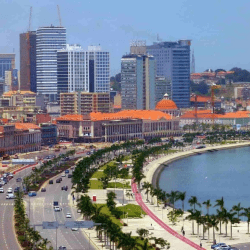Angola’s capital, Luanda, is also the largest city in the country.
Luanda and its metropolitan area is the most populous in Angola with over 8.3 million inhabitants in 2020 (a third of Angola’s population).

The capital is also the country’s primary port, major industrial, cultural and urban centre.
Located on Angola’s northern Atlantic coast, Luanda is Angola’s administrative centre, its chief seaport, and also the capital of the Luanda Province.

Luanda is among the oldest colonial cities of Africa, it was founded in January 1576 as São Paulo da Assunção de Loanda by Portuguese explorer Paulo Dias de Novais.

The city served as the centre of the slave trade to Brazil before its prohibition.
At the start of the Angolan Civil War in 1975, most of the white Portuguese left as refugees, mostly for Portugal.
The city is underwent major reconstruction, with many large developments that altered its cityscape significantly.
The industries present in the city include the processing of agricultural products, beverage production, textile, cement, new car assembly plants, construction materials, plastics, metallurgy, cigarettes and shoes.
The city is also notable as an economic centre for oil, and a refinery is located in the city.
The inhabitants of Luanda are mostly members of the ethnic group of the Ambundu, but in recent times there has been an increase of the number of the Bakongo and the Ovimbundu.
There exists a European population, consisting mainly of Portuguese.




Angola
Angola is a country on the west-central coast of Southern Africa. It is bordered by Namibia to the south, the Democratic Republic of the Congo to the north, Zambia to the east, and the Atlantic Ocean to the west.
Angola has an exclave province, the province of Cabinda, that borders the Republic of the Congo and the Democratic Republic of the Congo.

Basic facts
Capital: Luanda
Official language: Portuguese
Currency: Angolan Kwanza
Government: Republic, Presidential system, Unitary state
Population: 34.5 million (2021) World Bank
Dialing code: +244
| Urban Population, 2020: | 66.8% |
| Female Population, 2020: | 51.2% |
| GDP: | US$ 58.5 Billion |
| GNI Per Capita 2016: | US$ 2,230 |
| Inflation Rate December 2020: | 25.1% |
| Crude Birth Rate 2020(per 1000): | 42.72% |
| Human Development Index (rank / 189): | 148 |
| Human Development Index (scale 0 to 1): | 0.581 |
| Membership Date: | 23/06/1980 |
| Cumulative Approvals (1980-2021): | UA 2.95 Billion |




As of 2021, the Angolan population is estimated at 32.87 million. Angola is multicultural and multiethnic. Angolan culture reflects centuries of Portuguese influence, namely the predominance of the Portuguese language and of the Catholic Church, intermingled with a variety of indigenous customs and traditions.
Angola has vast mineral and petroleum reserves, and its economy is among the fastest-growing in the world, especially since the end of the civil war; however, economic growth is highly uneven, with most of the nation’s wealth concentrated in a disproportionately small part of the population.
The standard of living remains low for most Angolans; life expectancy is among the lowest in the world, while infant mortality is among the highest.
The largest investment and trade partners are China, the European Union, and the United States.
Angola is a member of the United Nations, African Union, the Community of Portuguese Language Countries, and the Southern African Development Community.
